Did you know that 40% of things we do daily are habitual, i.e. done out of habit? You constantly juggle between checking Facebook and getting back to finishing that urgent report your boss is asking for the past 2 hours. On weekends you could have done anything – Hit the gym, read an unfinished book […]
Updated 15 January 2024

VP – Pre Sales at Appventurez
Did you know that 40% of things we do daily are habitual, i.e. done out of habit?
You constantly juggle between checking Facebook and getting back to finishing that urgent report your boss is asking for the past 2 hours.
On weekends you could have done anything – Hit the gym, read an unfinished book or pen down the thoughts you’ve been thinking about for weeks. Instead, you choose to spend your free time watching Netflix or scrolling social media.
You wrestle with your conflicting thoughts yet choose to virtually stroll continuously through social media.
Whenever a certain query pops up in your mind, you immediately google it up.
All these instincts are the power of habit!
Though fascinating, it is sometimes scary to see how mobile app developers are fusing technology and psychology to be a massive success with users.
Consider apps like TikTok, PUBG, Pokemon Go and Snapchat. These apps don’t necessarily demand your attention but emit some sort of immense addiction radiation that is hard (almost impossible) to ignore.
Why?
Because technology has become addictive, i.e. businessmen, entrepreneurs and of course, developers are following trending app ideas for business and hooked models in mobile apps that sustain our attention and keep us coming back for more.
‘It’s as if they’re taking behavioural cocaine and just sprinkling it all over your interface and that’s the thing that keeps you coming back and back and back’, cites former Mozilla and Jawbone employee Aza Raskin.
In this blog post, we talk about the hooked model in mobile apps, the process of creating habit-forming mobile apps from scratch. On our way, we have highlighted the principles behind popular hooked apps to understand the essence.
The ultimate dream is to build an app, people will love to use and get crazy about. However, it’s heartbreaking when you build something and no one cares about it. Well, the bitter truth is there is no such thing as a product that sells itself.
The biggest challenge is not only getting new users but keeping the existing ones engaged and coming back. So how do you make sure your app is captivating and is able to retain users? You build the best habit-forming app via Nir’s framework.
To understand more about the hook model, kindly read or order Hooked: How to Build Habit-Forming Products book.
An entrepreneur, author, and behavioural economist, Nir Eyal, developed the Hook or Hook Model framework. He describes the framework as a staircase to create successful habit-forming products (products that bring users back to your app without relying on additional marketing/messaging tactics).
The model is made up of 4 steps:
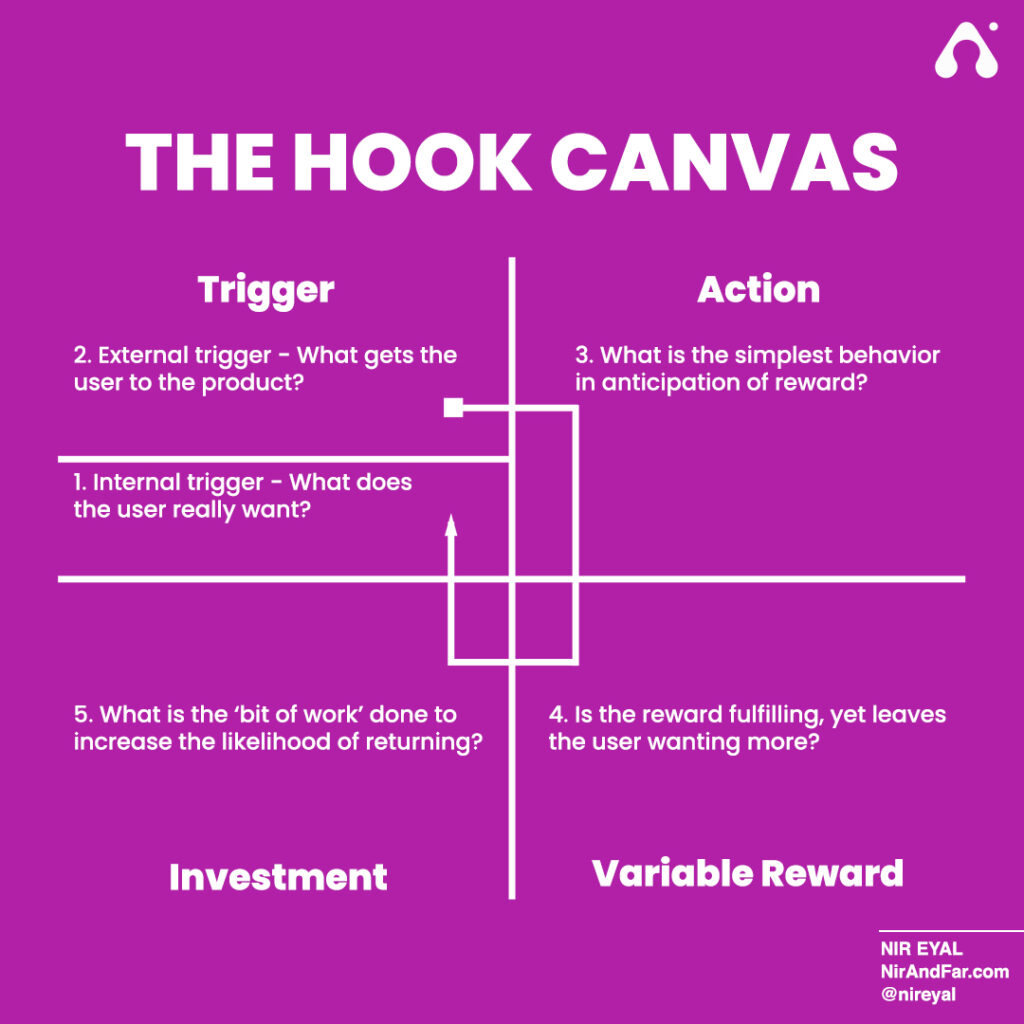
That irresistible urge to pick up your smartphone and use the app is called a trigger.
The hook starts with a trigger that prompts the habit. The Trigger compels the user to use the app and take an action.
Let’s say Anushka loves online shopping and shops 5-6 times a month. She downloads her favourite shopping app to stay on top of new deals and sales. One regular afternoon, she receives a push notification from the app that she has earned coupons for discounts up to 70% off. Intrigued, Anushka taps to find out more and shops more than usual.
With time, Anushka feels more connected to the app and its services and is more likely to engage on her own without any need for push notifications or messages.
We all know how push notifications cause an instant click in our minds. Here’s how push notification value increases with intensity.
Triggers are further categorised into two types-
When working hard to build revenue generating apps, you can facilitate external triggers to create a Hook and gradually build an emotional rapport between the product and the user. This will further lead to internal triggers without you having to initiate the one.
After the trigger, now comes the intended action. Say you have free time. You open the Instagram, scroll, enjoy the posts, watch reels and double-tap on a couple of them. Furthermore, maybe you get inspired by a post and try to follow it.
‘For any user behaviour, there should be considerable motivation, ability and trigger put together’, says B.J. Fogg, a behaviour scientist at Stanford University. Put simply-
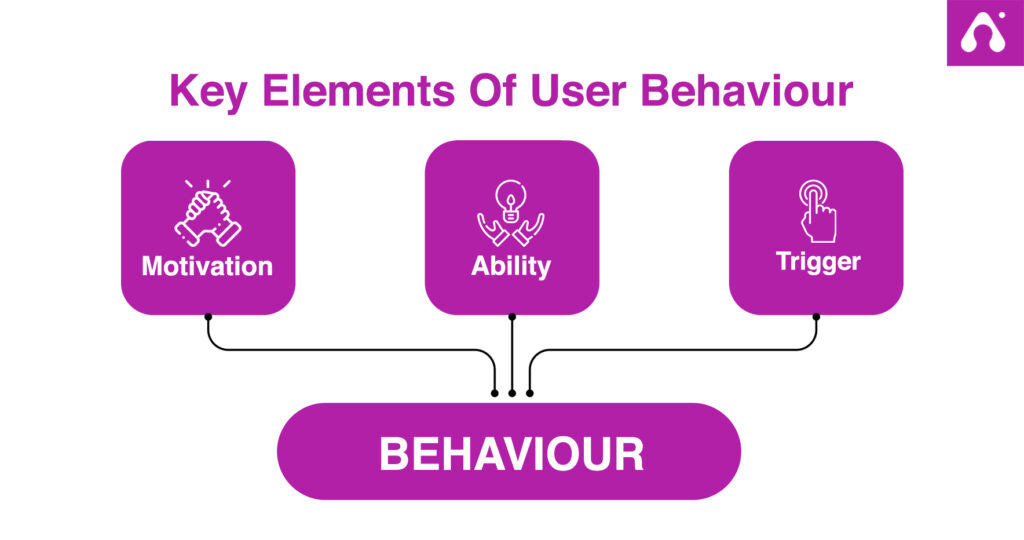
To create addictive custom mobile applications for businesses that amalgamate ability with motivation, make sure your application has hooks to make the users cling to it.
‘Hooks’ here means incorporating features that work well even when the internet is slow. Also, your app should be lightweight so that it can load in microseconds. You should consider following offline mobile application development to include offline features to keep the users entertained.
How about getting a surprise gift every time you shop something online? Sounds intriguing right!
People get highly motivated by rewards, and lo and behold, variable rewards. Variable rewards are among the most powerful tools integrated to hook users. App owners should be aware that what users actually seek from their app is a feeling of happiness, satisfaction or fulfillment.
Nir Eyal illustrates the idea through an example of a refrigerator:
“The predictable response of your fridge light turning on when you open the door doesn’t drive you to keep opening it again and again. However, add some variability to the mix—say a different treat that magically appears in your fridge every time you open it—and voila, intrigue is created.“
Such rewards not only make the users feel good, but they also multiply the effect of satisfaction such that users end up spending more time on your app and taking action.
The image below displays the type of variable rewards.
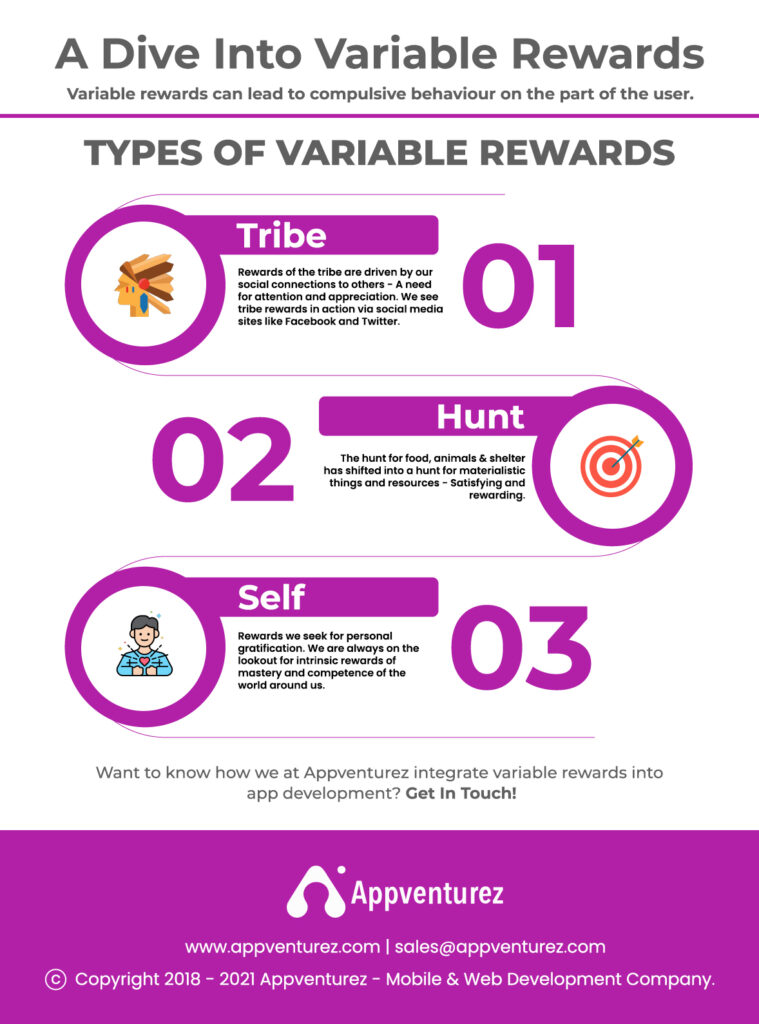
Today apps are not merely software to get rid of boredom or simply finish a task. Your software development partner should have a unique idea to compel users to come back to it instinctively.
Once the user gets hooked to an application, they begin investing. And the amount of investment depends on their reaction towards the hook – features that make your users return to your app for more. For example – Tag into a picture, mentions in comments, likes/shares or live stories.
A developer with acute knowledge knows how to increase app user engagement by pulling you more into the app you have invested a portion of yourself into. He/She knows the ins and outs to make you a regular visitor of the same by making your experience worthy. This way you develop the knack for that product.
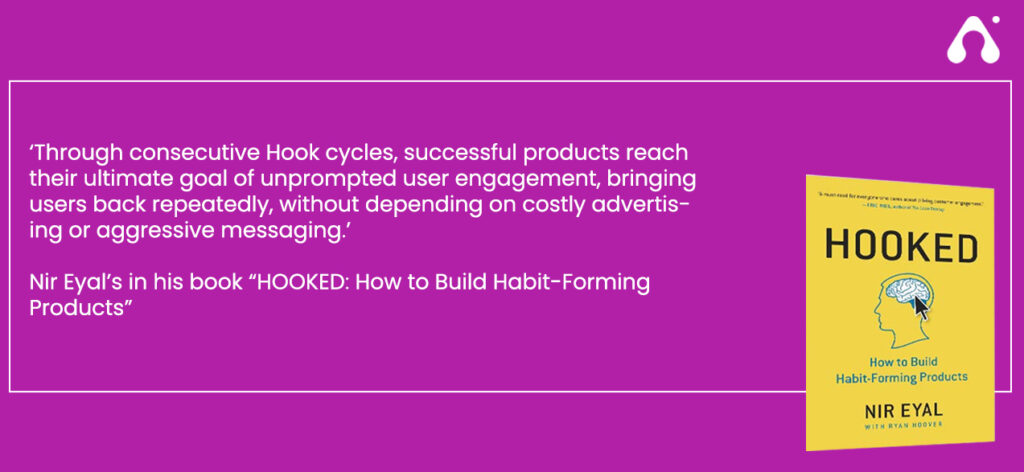
Now that you are aware of how a user’s psychology works and the ways to unlock it, let’s study some popular apps that have perfected the art of the Hooked model to place your app in the same league.
Behind every screen on your phone, there are generally literally a thousand engineers that have worked on this thing to try to make it maximally addicting.
-Aza Raskin, Former Mozilla and Jawbone employee
The hooked model in mobile apps is not a new concept, just lesser-known and often ignored. In this section, we discuss how social media platforms use the hook model. It explains why and how user behaviour can be influenced; how good habits are formed and at the same time why Instagram or Facebook services are highly addictive.
Let’s decode the success formula behind these two most popular apps-
Whenever a notification pops up on your screen, you get excited and start pondering over who would have sent you a notification.
The feeling to get rid of boredom and FOMO and seeking connection hits.
Unable to resist, you open the screen and see the notification of a friend tagging you in memory, liking or commenting on your recent post. You get persuasive to click on it which takes you directly to the app.
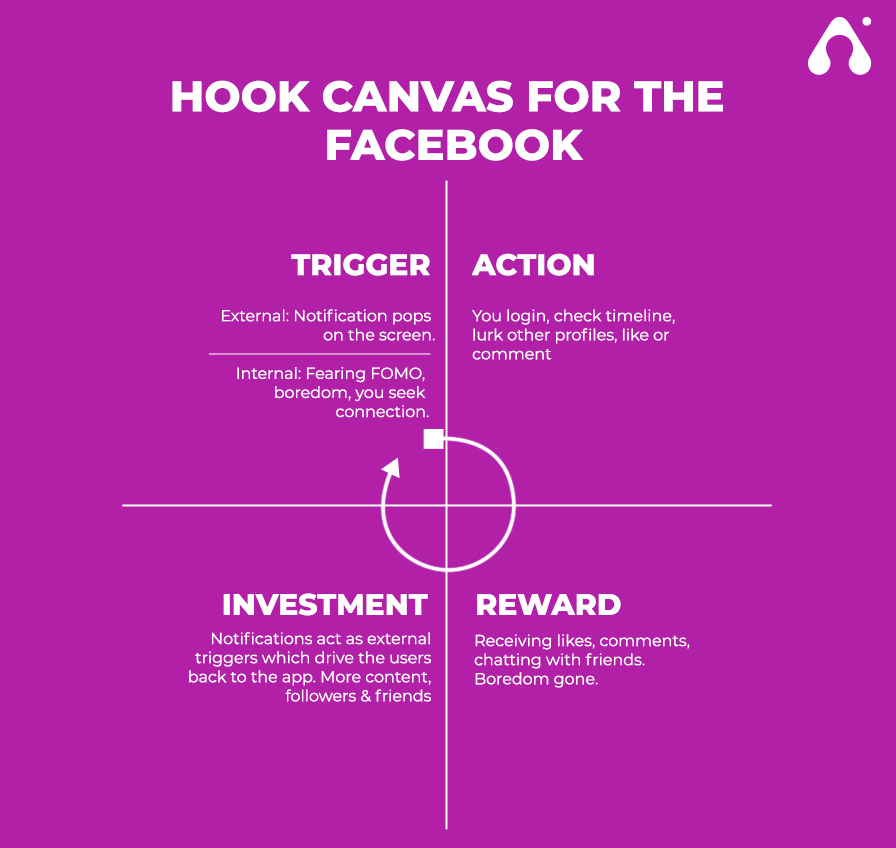
The throwback photo makes you feel overjoyed and recall those memories. You react to it and feel an urge to connect with that friend. You feel engaged in virtual conversation and social acceptance.
The notifications act as external triggers which drive you back to the service; Adding friends, liking posts, commenting and staying socially connected.
You open up your mobile and see there is a notification from Instagram. You swipe left/tap and dive right into the app to see what’s new and connect with friends.
You carry out certain tasks (sliding into DMs, reading a message, tagging your friends into memes, uploading a post or replying) due to the trigger.
Likes, comments and shares; All these invokes excitement and social acceptance.
Reward acts as the internal trigger that makes the users post again and enjoy other services. This is an investment into the app.
The hooked model in mobile apps has been highly successful to the extent that you don’t need any notifications to prompt you to open them. The trigger is your need to connect with your friends and check out new content as soon as you wake up. It has become a part of your routine. So now, anytime you are alone and feel the need to connect with someone, you go through these social media apps.
Now that you know the tips to increase mobile app response rate by conforming to the ethics of creating a habit-forming product, it’s time to know the mobile app retention strategies.
If you want your users to visit your app even once daily, it should be persuasive enough and be used out of habit.
As an app owner, rather than solving the pain points, presenting something unique to the table has become of prime importance. Identify a simple goal to begin with. If there is no problem to solve, introduce something different- something users may not easily reckon.
Take Uber for example. The app was built with a simple goal in mind: Offer car/cab/auto services anywhere, anytime at the tap of a button. That’s where the app gained recognition and built its reputation. Soon, it became the one people rely upon to travel hassle-free paying affordable fees.
Do not make the first version of your app too complex. The initial focus should be on delivering value to your audience and collecting information/insights on how you can improve the experience further.
Once you have set your eyes on a single focus, it clears the canvas to create a simple design. No, by simplicity we don’t mean to have minimal features; We mean something which is decent, easy for a user to grasp without much jargon, get them started and move them easily through the process of achieving a few key goals. Focus on minimalism, ease and simplicity to influence the user’s decision to come back for your services in the future.
Onboarding is about retention, not acquisition.
-ConversionXL
A good first impression is made with a persuasive onboarding process; A process when your app is first introduced to the users.
Mobile app onboarding is the staircase to success. A good onboarding experience is crucial to up your mobile app engagement rates and user lifetime value. Apart from an effective hooked model in mobile apps, cutting-edge design, complete user satisfaction and value for services, ahead are mobile app onboarding best practices you should follow when designing your onboarding process:
Coming back to the starting point and our topic, Habit-driven Hooked Model is a great tool to fall back on when developing the app. Once you have tapped into the psychology of your users via great design, there is no looking back.
“To change behaviour, products must ensure the user feels in control. People just want to use the service, not feel they have to”, mentions Nir Eyal in his book Hooked.
Before developing a habit-forming product, see if your app has a high visibility rate and is rightly optimized in the App stores (Follow this mobile app store optimization guide) so that people can know about it and download it.
Building an app with the latest business intelligence tools and techniques is simply not enough. Following a hooked model in mobile apps promises to engage and retain users by making your app a daily habit for them and invest in progressively.
Competition is fierce than ever. The more cycles through the hook model, the more hooked your users will become.
Study other Hooked models with higher app engagement to understand how the users’ psychology works. Learn from their experience to build a strategy or else, face the risk of falling behind. Apply the knowledge gained in this blog to get a bang for your buck.


Elevate your journey and empower your choices with our insightful guidance.

VP – Pre Sales at Appventurez
Anand specializes in sales and business development as its VP - Sales and Presales. He supervises the pre-sales process by upscaling on establishing client relationships. He skillfully deploys instruments such as cloud computing, automation, data centers, information storage, and analytics to evaluate clients’ business activities.
You’re just one step away from turning your idea into a global product.
Everything begins with a simple conversation.